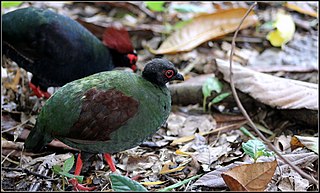
A partridge is a medium-sized galliform bird in any of several genera, with a wide native distribution throughout parts of Europe, Asia and Africa. Several species have been introduced to the Americas. They are sometimes grouped in the Perdicinae subfamily of the Phasianidae. However, molecular research suggests that partridges are not a distinct taxon within the family Phasianidae, but that some species are closer to the pheasants, while others are closer to the junglefowl.

The Phasianidae are a family of heavy, ground-living birds, which includes pheasants, partridges, junglefowl, chickens, turkeys, Old World quail, and peafowl. The family includes many of the most popular gamebirds. The family includes 185 species divided into 54 genera. It was formerly broken up into two subfamilies, the Phasianinae and the Perdicinae. However, this treatment is now known to be paraphyletic and polyphyletic, respectively, and more recent evidence supports breaking it up into two subfamilies: Rollulinae and Phasianinae, with the latter containing multiple tribes within two clades. The New World quail (Odontophoridae) and guineafowl (Numididae) were formerly sometimes included in this family, but are now typically placed in families of their own; conversely, grouse and turkeys, formerly often treated as distinct families, are now known to be deeply nested within Phasianidae, so they are now included in the present family.

Pica is a genus of seven species of birds in the family Corvidae in both the New World and the Old. It is one of several corvid genera whose members are known as magpies.

Junglefowl are the only four living species of bird from the genus Gallus in the bird order Galliformes, and occur in parts of South and Southeast Asia. One of the species in this genus, the red junglefowl, is of historical importance as the direct ancestor of the domestic chicken, although the grey junglefowl, Sri Lankan junglefowl and green junglefowl are likely to have also been involved. The Sri Lankan junglefowl is the national bird of Sri Lanka. They diverged from their common ancestor about 4–6 million years ago. Although originating in Asia, remains of junglefowl bones have also been found in regions of Chile, which date back to 1321–1407 CE, providing evidence of possible Polynesian migration through the Pacific Ocean.
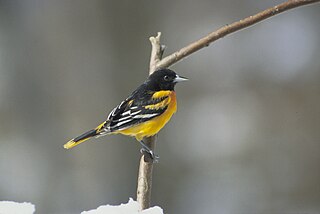
New World orioles are a group of birds in the genus Icterus of the blackbird family. Unrelated to Old World orioles of the family Oriolidae, they are strikingly similar in size, diet, behavior, and strongly contrasting plumage. As a result, the two have been given the same vernacular name.

The double-spurred spurfowl is a gamebird in the pheasant family Phasianidae of the order Galliformes, gallinaceous birds. Like most spurfowls, it is restricted to Africa. It is a resident breeder in tropical west Africa, but there is a small and declining isolated population in Morocco.

The bird genus Balearica contains two extant species in the crane family Gruidae: the black crowned crane and the grey crowned crane.

The grey-breasted martin is a large swallow from Central and South America.
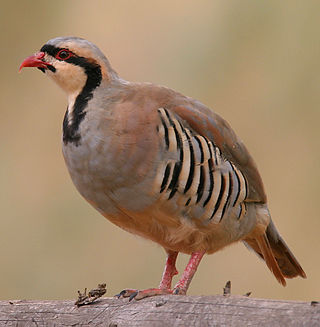
Alectoris is a genus of partridges in the family Phasianidae, closely related to Old World quail, snowcocks (Tetraogallus), partridge-francolins (Pternistis), bush quail (Perdicula), and sand and see-see partridges (Ammoperdix). Members of the genus are known collectively as rock partridges. The genus name is derived from the Ancient Greek: αλέκτωρ, romanized: alektoris, meaning "chicken" or "farmyard fowl".

The Tibetan partridge is a gamebird in the pheasant family Phasianidae of the order Galliformes. They are found widely across the Tibetan Plateau and have some variations in plumage across populations. They forage on the ground in the sparsely vegetated high altitude regions, moving in pairs during the summer and in larger groups during the non-breeding season. Neither males nor females have spurs on their legs.
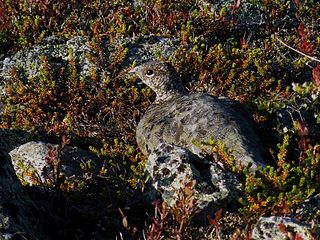
Lagopus is a small genus of birds in the grouse subfamily commonly known as ptarmigans. The genus contains three living species with numerous described subspecies, all living in tundra or cold upland areas.

Asio is a genus of typical owls, or true owls, in the family Strigidae. This group has representatives over most of the planet, and the short-eared owl is one of the most widespread of all bird species, breeding in Europe, Asia, North and South America, the Caribbean, Hawaii and the Galápagos Islands. Its geographic range extends to all continents except Antarctica and Australia.

Porphyrio is the swamphen or swamp hen bird genus in the rail family. It includes some smaller species of gallinules which are sometimes separated as genus Porphyrula or united with the gallinules proper in Gallinula. The Porphyrio gallinules are distributed in the warmer regions of the world. The group probably originated in Africa in the Middle Miocene, before spreading across the world in waves from the Late Miocene to Pleistocene.

Ciconia is a genus of birds in the stork family. Six of the seven living species occur in the Old World, but the maguari stork has a South American range. In addition, fossils suggest that Ciconia storks were somewhat more common in the tropical Americas in prehistoric times.

Passer is a genus of sparrows, also known as the true sparrows. The genus contains 28 species and includes the house sparrow and the Eurasian tree sparrow, two of the most common birds in the world. They are small birds with thick bills for eating seeds, and are mostly coloured grey or brown. Native to the Old World, some species have been introduced throughout the world.

The jungle bush quail is a species of quail in the family Phasianidae. It is native to the Indian subcontinent, where it is found in peninsular India and Sri Lanka. It has also been reported from Nepal but has not been seen there since the 19th century, and an introduced population exists on the island of Réunion. A small species of quail 15–18 cm (5.9–7.1 in) long and weighing 57–82 g (2.0–2.9 oz), it shows significant sexual dimorphism. Males have brown upperparts with blackish and buff marking and whitish underparts with black barring. The face is mainly dark reddish-brown, with brown ear-coverts, a buffy-white moustachial stripe, and the supercilium turning whitish towards the back of the neck. Females have a similar pattern, but with pinkish-brown underparts, more uniform wings, and duller moustachial stripes.

The yellow canary is a small passerine bird in the true finch family. It is a resident breeder in much of the western and central regions of southern Africa and has been introduced to Ascension and St Helena islands.
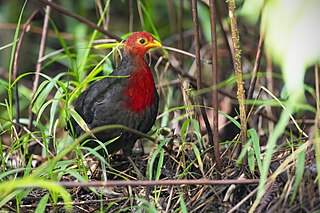
The crimson-headed partridge is a species of bird in the pheasant, partridge, and francolin family Phasianidae. Described by the British ornithologist Richard Bowdler Sharpe in 1879, it is the only species in the genus Haematortyx. It is endemic to Borneo, where it inhabits lower montane forest in the northern and central parts of the island. It is mainly found at elevations of 1,000–1,700 m (3,300–5,600 ft), but can be seen as low as 185 m (607 ft) and as high as 3,050 m (10,010 ft). Adult males have a striking appearance, with a dark blackish body and crimson red heads, necks, breasts, and undertail coverts. Females have a similar pattern, but with duller brownish-black colouration, orangish-red heads and breasts, and a brownish-black bill instead of a yellowish one. Juveniles are duller and have the crimson restricted to the top of the head.

The wood quails are birds in the genus Odontophorus of the New World quail family, which are residents in forests in the Americas. The core range of the genus is centered in the lowlands and foothills of the northern Andes of Colombia and the mountain ranges of Central America; however, some species occur elsewhere in tropical and subtropical South America.

The green-backed trogon, also known as the Amazonian white-tailed trogon, is a bird in the trogon family Trogonidae. It is widely distributed across the Amazon rainforest with a disjunct population on the southeast coast of Brazil. As with all trogons, this species is sexually dimorphic. The male has a yellow belly without a white breastband, a blue head with a pale-blue orbital eye-ring, a blue bill, a green back and a green tail that is mostly white below. The female is duller with a dark grey head, a dark grey back and some black barring beneath the tail.



























